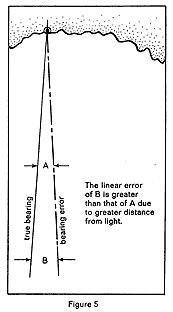Before you start taking sights on any aids to navigation, you should select the ones you will use. Your choice may well influence your degree of accuracy.
The selection process can be broken down into three steps. The first step is to decide which objects you will observe as you move along your charted course. This is called the overall selection, and the marks can be labelled A, B, C, D, E, F, etc. Always do this in advance. Appraise every detail of the respective charts and review the sailing directions, light lists and tide tables.
Next, familiarize yourself with the sailing area, determine your courses and select the aids to navigation you will use to sight your visual fixes. Always try to use lighthouses, spires, cupolas, etc., for all have well-defined observation points. A bold headland is good only for sighting a tangent bearing.
If possible, avoid using large buildings and most mountains, for there is usually some doubt about the exact point you should use for the observation. Buoys are not recommended for bearing marks for they are secured by an anchor and swing in an arc. Because they are not fixed, buoys may be shifted off station by ships, storms, or tides. And occasionally, they are deliberately moved. Unless you keep your charts up to date with the Notice to Mariners, you may well be in error.
Try not to sight tangents off islands or low points of land. You will have an error if the shore is shelving and the tide is above the chart datum. And what may appear as a long point at low water, may disappear altogether at high tide. If there is great tidal range, you could have substantial error (Fig. 2).

When you've determined all your potential aids to navigation as well as backups (in case those picked can't be recognized with absolute sureness), list them in a visual bearing notebook. Record tower and lighthouse heights; they'll be handy when you are determining ranges.
When you are moving along your charted course, visualize where you Flight expect to sight the objects, and what they'll look like. When you get in the area, scan the horizon for the first sighting. If you locate and identify a distant object with binoculars, observe the cloud formation above it; it will make it easier to locate and sight the bearing. When you take your bearing, record the time, the object and the bearing, in degrees in the notebook (Fig. 3).

Once you have several of your selected aids to navigation in view, you should be aware that certain combinations produce greater accuracy than others. For example, when the angle between two objects is decreasing, a small error in either bearing will throw the fix off by an increasing amount (Fig. 4).
When you are getting a fix with cross bearings, the best fix is obtained when at least two bearing lines cross each other at 90'. You might sight one object dead ahead, and another abeam. If this is not possible, always try to select objects with no less than 30' nor more than 150' between each pair.
Always consider the distance an object is away from you. The closer the better because the linear error resulting from an angular error always increases with distance (Fig. 5). For example, an angular error of 2' represents a linear error of 200' if the object is one mile away; at ten miles, the same 2' error represents 2,000'!

When you're determining range with a sextant or stadimeter, the distance, height and location are the key elements that must be considered. The closer and the higher the object, the greater is the measured angle and the more reliable is the range reading.
Remember that the stated height of a lighthouse, in the light list, is always listed above high water. Its height must be corrected for tide.
When you are "shooting" your bearings, the sighting sequence will affect your accuracy. Always sight first the object whose bearing is changing most slowly, This will probably be one either dead ahead or dead astern. In considering objects with rapidly changing bearings, the ones nearest the beam should be sighted last. The time of the last sighting should be the time of your plotted fix. If you combine ranges with bearings, observe the vertical angles first, since observation is quicker with a pelorus. This means you won't lose any plotting time after a sextant or stadimeter reading; and the pelorus bearings will be the most up-to-date.
When you are selecting your "targets" for bearings, keep in mind that the angles between them should be as close as possible to 90 degrees, and that nearby objects are preferable to distant ones. And always shoot the objects having slowly changing bearings first. If you are getting ranges with vertical angles, remember that high objects near the shoreline will yield the best results.
Keep these points in mind and you should avoid the confusion that results from not knowing where you are the next time you sail into strange waters.